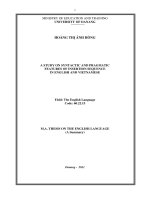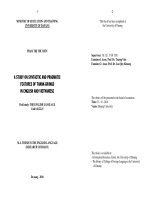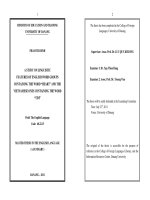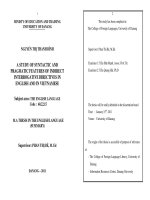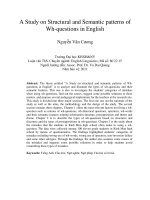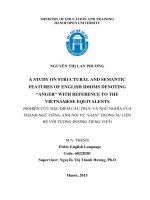A study on syntactic and semantic features of idioms denoting SADNESS in english with reference to the vietnamese equivalent
Bạn đang xem bản rút gọn của tài liệu. Xem và tải ngay bản đầy đủ của tài liệu tại đây (1003.93 KB, 92 trang )
MINISTRY OF EDUCATION AND TRAINING
HANOI OPEN UNIVERSITY
M.A. THESIS
A STUDY ON SYNTACTIC AND SEMANTIC FEATURES
OF IDIOMS DENOTING SADNESS IN ENGLISH WITH
REFERENCE TO THE VIETNAMESE EQUIVALENTS
(NGHIÊN CỨU ĐẶC ĐIỂM CÚ PHÁP VÀ NGỮ NGHĨA CỦA THÀNH
NGỮ TIẾNG ANH BIỂU THỊ CẢM XÚC BUỒN TRONG SỰ LIÊN HỆ
TƯƠNG ĐƯƠNG VỚI TIẾNG VIỆT)
NGUYỄN THỊ VINH
Hanoi, 2016
MINISTRY OF EDUCATION AND TRAINING
HANOI OPEN UNIVERSITY
M.A. THESIS
A STUDY ON SYNTACTIC AND SEMANTIC FEATURES
OF IDIOMS DENOTING SADNESS IN ENGLISH WITH
REFERENCES TO THE VIETNAMESE EQUIVALENTS
(NGHIÊN CỨU ĐẶC ĐIỂM CÚ PHÁP VÀ NGỮ NGHĨA CỦA THÀNH
NGỮ TIẾNG ANH BIỂU THỊ CẢM XÚC BUỒN TRONG SỰ LIÊN HỆ
TƯƠNG ĐƯƠNG VỚI TIẾNG VIỆT)
NGUYỄN THỊ VINH
Field: English Language
Code: 60220201
Supervisor: Assoc. Prof. Dr. Phan Văn Quế
Hanoi, 2016
CERTIFICATE OF ORIGINALITY
I do hereby certify my authority of the study project report entitled “A
study on syntactic and semantic features of idioms denoting SADNESS in
English with reference to the Vietnamese equivalents” submitted in partial
fulfillment of the requirements for the degree of Master in English
Language. Except where the reference is indicated, no other person’s work
has been used without due acknowledgement in the text of the thesis.
Hanoi, 2016
Nguyễn Thị Vinh
SUPERVISOR
Assoc. Prof. Dr. Phan Văn Quế
Date: ……………………
i
ACKNOWLEDGEMENTS
In the first place, I wish to express my deepest gratitude to my
supervisor, Assoc. Prof. Dr. Phan Văn Quế, for his patient guidance, helpful
suggestions, encouragement and constructive supervision in writing of this
report. His enlightening suggestions and detailed comments have shaped
this dissertation largely. Without his help, this field study report would have
been impossible.
A special word of thanks goes to all my lecturers at Ha Noi Open
University and many others, without whose support and encouragement it
would never have been possible for me to have this thesis accomplished.
Thanks are also due to all other staff members of English Department
at Hung Yen Medical College who have been of great help.
I am indebted to all those who have kindly advised and helped me
towards the completion of my study report.
Last but not least, my sincere thanks go to my family whose love and
encouragement have been equally important to my educational endeavors,
especially my husband and my children who encouraged and helped me to
carry out the thesis.
ii
ABSTRACT
This study investigates syntactic and semantic features of idioms
denoting SADNESS
in
English with
reference
to
the Vietnamese
equivalents. Basing on the description and analysis of distinguishing
features, the similarities and differences of idioms in the two languages are
presented. The data includes236 samples in English and Vietnamese, from
various linguistic books, dictionaries and from the internet and they are
analyzed both qualitatively and quantitatively. The findings show that
idioms relating denoting SADNESS have remarkable syntactic and semantic
features in the two languages such as phrases, and structures are identical to
some extent. In the semantic aspect, the occurrence fields are almost same
in English and Vietnamese. There is only one feature difference. These
findings lead to some implications for the language learning and teaching. It
is hoped that the study will be useful to those who teach and study English
as well as ones who are interested in idioms denoting SADNESS.
iii
LIST OF ABBREVIATIONS
A: Adjunct
Adj: Adjective
Adj. P: Adjective Phrase
Adv: Adverb
Adv.P: Adverb Phrase
App: Appositive
Art: Article
C: Complement
Cadj: Complement of Adjective
Cprep: Complement
N: Noun
NP: Noun Phrase of preposition
Num: Number
Prep : Preposition
Prep P: Preposition Phrase
S: Subject
V: Verb
VP: Verb Phrase
iv
LIST OF TABLES
Table 2.1
Similarities and differences between proverbs and idioms
24
Table 4.1
A summary of idioms denoting SADNESS in English with
55
reference to the Vietnamese in terms of syntactic
features
Table 4.2
A Statistical Summary of syntactic features of idioms
56
denoting SADNESS in English with reference to the
Vietnamese
Table 4.3
A Statistical Summary of Semantic Features of idioms
63
denoting SADNESS in English with reference to the
Vietnamese
v
TABLE OF CONTENTS
Certificate of originality.....................................................................................i
Acknowledgements ............................................................................................i
Abstract ..............................................................................................................iii
List of abbreviations ..........................................................................................iv
List of table ........................................................................................................v
CHAPTER 1: INTRODUCTION ................................................................ ....1
1.1. Rationale of the research ............................................................................1
1.2. Aims of the research.............................................................................. .....2
1.3. Objectives of the study.......................................................................... .....3
1.4. Scope of the study .......................................................................................3
1.5. Significance of the study ......................................................................... ..4
1.6. Structural organization of the study............................................................5
CHAPTER 2: LITERATURE REVIEW.......................................................... 6
2.1. Review of previous studies .........................................................................6
2.2. Review of theoretical background ..............................................................8
2.2.1. Theoretical framework.............................................................................8
2.2.1.1. Theory of syntax ...................................................................................8
2.2.1.2. Theory of semantics ..............................................................................9
2.2.2. Overview of English and Vietnamese idioms .........................................10
2.2.2.1. Definition of English idioms ................................................................10
2.2.2.2. Features of English idioms ...................................................................12
2.2.2.3. Features of Vietnamese idioms .............................................................19
2.2.3. Classification of idioms ...........................................................................22
2.2.3.1. Idioms and Proverbs .............................................................................22
2.2.3.2. Idioms and phrases ...............................................................................25
2.2.4. Overview of SADNESS ..........................................................................26
2.2.4.1. Definition of Sadness ............................................................................26
2.2.4.2. Idioms denoting Sadness .....................................................................27
2.5. Summary .....................................................................................................27
CHAPTER 3: METHODOLOGY .....................................................................28
3.1. Research-governing orientations ................................................................28
3.1.1. Research questions...................................................................................28
3.1.2. Research setting .......................................................................................29
3.1.3. Research approach ...................................................................................29
3.1.4. Criteria for intended data collection and data analysis ............................30
3.2. Research methods .......................................................................................31
3.2.1. Major methods vs supporting methods ....................................................31
3.2.2. Data collection techniques .......................................................................32
3.2.3. Data analyses techniques .........................................................................32
3.3. Summary .....................................................................................................33
CHAPTER 4: FINDINGS AND DISCUSSION ...............................................35
Overview ............................................................................................................35
4.1. Syntactic and semantic features of idioms denoting SADNESS in
English .......... ...................................................................................................35
4.1.1. Syntactic features .....................................................................................35
4.1.2. Semantic features ....................................................................................40
4.2. Similarities and Differences of idioms denoting SADNESS in English
with references to the Vietnamese equivalents in terms of their syntactic and
semantic features................................................................................................46
4.2.1. In term of their syntactic features ............................................................46
4.2.1.1. Similarities ............................................................................................46
4.2.1.2. Differences ............................................................................................48
4.2.2. In terms of their semantic features ..........................................................60
4.2.2.1. Similarities ............................................................................................60
4.2.2.2. Differences ............................................................................................63
4.3. Possible implications ..................................................................................66
4.4. Summary .....................................................................................................68
CHAPTER 5: CONCLUSION .........................................................................70
Overview ............................................................................................................70
5.1. Recapitulation .............................................................................................70
5.2. Concluding remarks ....................................................................................71
5.3. Limitations of the research .........................................................................72
5.4. Suggestion for future research .................................................................... 72
REFERENCE..................................................................................................... 73
APPENDIX: IDIOMS DENOTING SADNESS IN ENGLISH AND
IDIOMS DENOTING SADNESS IN VIETNAMESE ..................................... 77
CHAPTER 1
INTRODUCTION
1.1 Rationale of the research
Language plays an important role in human life because language is
the significant mean in communication. However, language of each country
can not be similar to each other due to its different culture, tradition, belief
and custom. Language and culture are two concepts which always go along
with each other and have close relationship with the development of their
nations.
In different nations, the meanings of the words and utterances are also
dissimilar. A word or a sentence can have plenty of meanings (literal
meaning, figurative meaning, denotative meaning and narrow meaning). For
example: In Vietnamese, “cơm niêu nước lọ”does not only mean “the rice in
the earthenware pot and the water in the jar” but also “the poor". Therefore,
it is easily misunderstood for those who study Vietnamese as a foreign
language.
With regard to the role of language and culture, the usage of idioms in
human life cannot be underrated. Idioms have been created along with the
development of communication in human society. Idioms reflect typical
culture, tradition, custom of each nation. Palmer (19) described that they are
expressions whose meanings cannot be inferred from the meaning of its
parts. The meaning of the idioms cannot be deduced from the individual
words because both the grammar and the order of words in the idiom are
fixed, and if their forms are changed, the idioms will lose their meanings.
The main messages of the idioms are often hidden under surface words, thus
it becomes a challenge for foreign language learners. In many case, idioms
1
sound naturally and fit occasion by native speaker using, whereas, a nonnative speaker of English may know the basic meaning but still cannot use it
appropriately. Therefore, understanding the meaning of idioms and the way
using them is very important for learning one language. Being able to
mastering English idioms is likely to help learners of English feel more
confident in learning and communicating.
On the other hand, idioms denote various fields of human life such as
happiness, anger, fear, unhappiness, weather, human feeling etc., having
been studied by a number of researchers in Vietnam and overseas. However,
idioms denoting SADNESS seem to be open for being discussed and further
studied. SADNESS reflects
feature of human feeling which has been
studied in academic fields such as sociology, and psychology. With a view
to helping Vietnamese learners to have a thorough understanding of English
idioms and being able to avoid negative interferences in learning and culture
shock in communication. I choose the subject entitled “A study on syntactic
and semantic features of idioms denoting SADNESS in English with
reference to the Vietnamese equivalents” for my graduation thesis. It is also
hoped that the study could probably make a small contribution to figure out
English and Vietnamese idioms denoting Sadness
1.2 Aims of the research
The first aim of this research is to explore the syntactic and semantic
characteristics of English idioms denoting Sadness and its Vietnamese
equivalents in a contrastive analysis so as to find out similarities and
differences between them.
The second aim is to provide readers with fundamental understandings
about idiom in general and idioms denoting Sadness in particular.
2
The third aim is that through this research, I do hope to be able to
give some possible suggestions for Vietnamese EFL learners at Hungyen
medical college to improve the learners’ understanding and using idioms
denoting Sadness.
1.3. Objectives of the research
With the above aims, the first objective of the study is to find main
syntactic and semantic features of idioms denoting SADNESS in English
with reference to the Vietnamese equivalents.
The second objective is to discover the similarities and differences of
idioms denoting SADNESS in English with reference to the Vietnamese
equivalents in term of syntactic and semantic features.
The last one is to suggest some implications for teaching and learning
idioms denoting SADNESS in English.
1.4. Scope of the research
1.4.1. Academic scope
The research is expected to contribute an in-depth description of
idioms denoting SADNESS in English when analyzing their syntactic and
semantic features in comparison with their Vietnamese equivalents.
1.4.2. Social scope
To complete the research thesis, all the material collection of idioms
denoting SADNESS in English and their Vietnamese equivalents with
illustration examples are selected from some reliable dictionaries, reference
books and internet. It is hoped that the outcome of this research thesis, to
some extent, would be able to make a certain contribution to enhance the
3
quality of teaching and learning English of students at the Hung Yen
medical college.
All English and Vietnamese idioms denoting SADNESS which are
the most common are collected from dictionaries, books, and internet.
1.5. Significance of the study
1.5.1. Theoretical significance
This research is expected to provide some basic information of idioms
in terms of syntactic and semantics to help writers and researchers go to
further studies about this field. It is also intended to help teachers and
learners of English raise their socio- cultural awareness of the English
country.
1.5.2. Practical significance
There is a large number of English idioms denoting SADNESS
among English idioms but there have been no studies dealing with the
syntactic and semantic features of idioms denoting SADNESS in English
and their Vietnamese equivalent. As a result, this research is conducted in
attempt to provide Vietnamese learners of English with better mastering
how to apply this kind of idioms in sensible ways, how to thoroughly
understand and naturally use them in receptive and productive skills. In the
other words, the research is hoped to provide an important opportunity to
advance the understanding of idioms denoting SADNESS in English with
reference to the Vietnamese equivalents as well as make a major
contribution to the process of teaching and learning English.
4
1.6. Structural organization of the research
This paper consists of five chapters as follows:
Chapter I- Introduction - mentions to the rationale, the aim, the
objective, the scope, the significance and the structural organization.
Chapter II - Literature review- gives the overview of the previous
studies relating to the area of the research and covers some theoretical
backgrounds that could be used as foundation for the process of conducting
the research.
Chapter III - Methodology - presents the research questions and
research approach with various methods and techniques to conduct the
research thesis.
Chapter IV - Findings and discussions - describes and analyzes the
syntactic and semantic features of idioms denoting
English and Vietnamese
equivalents
and
provides
SADNESS in
some
possible
implications for teaching and learning idioms denoting SADNESS in
English and Vietnamese equivalents.
Chapter V – Conclusion - summaries the major findings resulted from
the investigation and data analysis, presents the limitations of the study, and
suggests some further researches.
5
CHAPTER 2
LITERATURE REVIEW
The literature review serves two main purposes. Firstly it gives a
review of previous studies related to English idioms in general and idioms
denoting Sadness in English in particular. Secondly it presents and discusses
the theoretical background which guides and plays as the foundation for this
research.
2.1. Review of previous studies
Idioms are used a lot in the field of communication and literature and
they have also been an interesting subject attracted many linguists and
researchers. So far, there have been many investigations into idioms. With
the different points point views as well as different objectives, linguists and
researchers have a variety of ways to interpret idioms
In English, there are many books, dictionaries and websites on
idioms. For example, in “Oxford Dictionary of English Idioms ” [5], Cowie,
Mackin and Mc Caig carefully collected and categorized idioms into
alphabetical arrangement. They also mentioned the meanings of idioms with
their examples of usage in English. Cruse [6] made the conception of idioms
clear by distinguishing idioms, collocations and “dead metaphor”. He
considered idioms as a semantically lexical complex. This author also gave
out a traditional viewpoint of idioms which was homophonous with
grammatically well-formed transparent expressions. Palmer [19] defined
idioms as consequences of words whose meanings could not be predicted
from the meanings of words themselves. He stated some restrictions in
syntactic as well as semantic features of idioms. Besides, Seiddli [20] and
Broukal [4] presented the collections of idioms. All of these help learners
6
get a wide knowledge of idioms as well as understand one easily. Howard
[10] classified idioms in terms of syntax and grammar. The author defined
idioms as being semantically opaque and stated that collocation could
provide a useful framework for revising idioms.
In Vietnamese, idioms have been also an interesting field for
linguists. Hoàng Văn Hành [24] deeply analyzed structural and semantic
features of idioms as well as collected a large amount of Vietnamese idioms.
Additionally, Nguyễn Như Ý, Nguyễn Văn Khang, Mai Xuân Thành [38]
published a dictionary in which they classified Vietnamese idioms in the
alphabetical order with their meaning and examples originally extracted
from novels, newspapers, magazines and so on. In “Thành Ngữ Tiếng Việt"
36], Nguyễn Lực and Lương Văn Đang showed a large number of idioms as
well as their variants which were collected with original examples extracted
from Vietnamese novels, newspapers and magazines. Besides, Nguyễn Lân
[34] has also arranged idioms in the alphabetical order and explained their
meanings. What is more, idioms have been recognized and explained with
particular examples in many books such “Giúp em học Thành Ngữ Tục Ngữ ”
by Đặng Thiêm [23], “Từ Điển Thành Ngữ Anh Việt" by Dương Ngọc DũngNinh Hùng [22], “Thành Ngữ & Tục Ngữ Việt Nam chọn lọc” by Trần Quang
Mân [39] and “Tuyển tập thành ngữ , tục ngữ , ca dao Việt -Anh thông
dụng” by Nguyễn Đình Hưng [27].and so on. Furthermore, there are several
research papers that have some relationship with various aspects of idioms.
For instance
"Semantic features of English and Vietnamese idioms of
happiness and sadness: A cognitive linguistic perspective"(2010) by Nguyễn
Thi Lâm."A contrast study of grammatical and semantic features of words
and idioms denoting unhappiness in English and Vietnamese" (2011) by
Nguyễn Thị Tân Bình. "A contrast analysis of idioms denoting human being
in English and Vietnamese" (2006) by Võ Thanh Quyên and "An
7
investigation intothe use of conceptual metaphor in English and Vietnamese
idioms denoting human feeling" (2012) by Nguyễn Hoàng Nam.
However, the investigation into syntactic and semantic features of
idioms denoting SADNESS in English and Vietnamese equivalents has not
been carried out yet. This is the reason why I decided to make an
investigation into idioms denoting SADNESS in English and Vietnamese
equivalents. I choose to study on this field with the hope of making some
contribution to the appropriate use of idioms denoting SADNESS in
learning and using them the communicative.
2.2. Review of theoretical background
2.2.1. Theoretical framework
2.2.1.1. Theory of syntax
Syntax is understood to be the theory of the structure of sentences in a
language. This view has its direct antecedents in the theory of immediate
constituents, in which the function of syntax is to mediate between the
observed forms of a sentences and its meaning. The form of a language
could not be understood if the complex forms to their ultimate constituents
were merely reduced all. Bloomfeild argue that in order to account for the
meaning of a sentence, it is necessary to recognize how individual
constituents (e.g. words and morphemes), constitute more complex forms,
which themselves constitute more complex forms.
Syntax is now the study of the principles and rules that govern the
ways in which words are combined to form phrases, clauses and sentences
in a language. Syntax which is subfield of grammar focuses on the word
order of a language and the relationships between words. In this use, syntax
8
is opposed to morphology, the study of word structure. In other words,
morphology deals with word formation out of morphemes whereas syntax
deals with phrase and sentence formation out of words.
Syntax structures (patterns or constructions) are analyzed into
sequences of syntactic categories or syntactic classes, these being
established on the basis of the syntactic relationships linguistic items have
with other items in a construction. Some studies propose an analysis
whereby categories are analyzed as set of syntactic features, to permit a
greater degree of generalization across categories.
2.2.1.2. Theory of semantics
Whereas syntax is the grammar, structure, or order of the elements in
a language statement, semantics is the meaning of these elements.
Semantics has a thousand-of-year history but the word “semantics” made it
earliest entry into the Old English Dictionary only in 1890s. Cliff Goddard(
1998) remarks that semantics, the study of meaning, is at the center of
linguistic quest to understand the nature of language and human language
abilities for two reasons. First, expressing meanings is what language is all
about- everything from words to grammatical constructions and structures.
Second, semantics can shed the light on the relationship between language
and culture.
The term “linguistic semantics” to state that linguistic
semantics is the study of meaning in so far so as it is systematically encoded
in the vocabulary and grammar of natural languages. On the other hand,
Frawley (1992) defines in obvious terms linguistic semantics as the study of
literal, contextualized, grammatical meaning. The most commonly agreedupon definition of semantics remains the one given by Bre’al as “the science
of the meanings of words and of the changes in their meaning”. With this
9
definition, semantics is included under lexicology, the more general science
of words, being its most important branch.
Semantics (as the study of meaning) is central to the study of
communication and as communication becomes more and more a crucial
factor in social organization, the need to understand it becomes more and
more pressing. Semantics is also at the centre of the study of the human
mind- thought processes, cognition, conceptualization- all these are
intricately bound up with the way in which we classify and convey our
experience of the world through language.
2.2.2. Overview of English and Vietnamese idioms
2.2.2.1. Definition of English idioms
So far, There have seen several definitions of idioms.
According to Wikipedia [42], the word “idiom” comes from the Latin
word “idiom” - it means “special property”. “It’s an expression consisting
of a combination of word that has a figurative meaning. The figurative
meaning is comprehended in regard to a common use of the expression that
is separate from the literal meaning or definition of the words of which it is
made”.
In the definition of Hornby [11, p.589], an idiom is “a phrase or
sentence whose meaning is not clear from the meaning of its individual
words and which must be learnt as a whole unit”.
Carter [3,p.65] defines “idioms as special combinations with
restricted forms and meanings that cannot deduced from the literal
meanings of the words which make them up.”
10
Fromkin, Collins and Blair [7, p. 231] defined idioms as “fixed
phrases, consisting of more than one word, with meanings that cannot be
inferred from the meanings of the individual words ”.
Cruse [6, p. 37] approved that “idioms is an expression whose
meaning cannot be inferred from the meanings of its parts. ”
Arthur [2, p. 364] described idioms as “a phrase which means
something different from the meanings of separate words”.
In Vietnamese, Hoàng Văn Hành [24, p. 25] defined “thành ngữ là một
loại tổ hợp từ cố định, bền vững về hình thái cấu trúc, hoàn chỉnh, bóng bảy về ý
nghĩa, được sử dụng rộng rãi trong giao tiếp hàng ngày ”.(Idioms are set
expressions which are stable in metaphor _ structure, complete and
figurative in meaning, used widely in daily communication).
According to Nguyễn Lân [43, p.6], “thành ngữ là những cụm từ cố
định dùng để diễn đạt một ý niệm”.(Idioms are fixed phrase to express a
concept).
For example :
Dở khóc, dở cười.
Nước mắt ngắn nước mắt dài
Dau lòng xót dạ
Nguyễn Thiện Giáp [39] stated that “những đơn vị định danh biểu thị
khái niệm nào đó dựa trên những hình ảnh, những biểu tượng cụ
thể”.(Idioms are set expressions that have both the complete in meaning and
valuable description. Idioms that express conceptions are usually based on
specific images and symbols”).
From these above definitions, there is no conflict between definitions
11
of idioms mentioned-above in spite of some different ways of expressing.
They integrate at one point that an idiom is a fixed expression whose
meaning cannot be worked out by combining the literal meaning of its
individual words . We can also recognize that most authors have the similar
view of idioms. They agree that idioms is “a word, a phrase, a set expression
”or “fixed phrase ”whose meaning does not concern the meaning of the
individual words in the expression.
From the structural point of view, most idioms are stable in structure
and restricted in lexicon. All of words in idioms are fixed. If we make
changes in idioms, their real meaning will not remain. For example, the
meaning of sob your heart out.It does not mean that your heart is sodded out
(sob your heart out means to cry noisily for very long time because you are
very sad ). In Vietnamese, the idiom “Mặt mày ủ dột”cannot be changed into
“mặt ủ mày dột ”or “Mặt nặng như chì ”cannot be understood as “mặt như chì
nặng”.
Semantically, the meaning of an idiom is different from the meaning
of individual words so it is hard to understand its meaning because it is built
by specific images and symbols with simile and metaphor. For example, in
the idiom down to the dump, we know the meaning of each word but it’s
difficult to get the meaning of the whole idiom (it means very unhappy)
In general, all of these above definitions, the one given by Fromkin,
Collins and Blair is the clearest definition of idioms. Therefore, it has been
considered as the main reference for my research.
2.2.2.2. Features of English idioms
Considering the definitions given so far and the defining features
discussed, idiom is defined from various aspects and for each aspect, typical
12
rather than the necessary features are stated in a general way below. These
features will be discussed in more detail in the next sections.
From a syntactic aspect, they usually have short and fixed forms.
They form a complete utterance which makes them unlike non-sentential
items like phrase.
From a semantic aspect, they does not
express wisdom, general
truths, morals, traditional views, experiences, observations, social norms,
human nature and behavior accepted by the majority in the society. They
expresses the reflection of concepts image, a phenomenon, a state, as
personality, or an attitude. Moreover, there is no cut distinction among these
aspects of idioms as there are overlaps between them. The aspects are all
complementary to each other. Moreover they have literal meaning and are
metaphorical meaning. They contain various figures of speech and thus,
they are parts of figurative language.
2.2.2.2.1. Syntactic features
According to the definition of idioms from Fromkin, Collins and
Blair [7, p.23], idioms are defined as “fixed phrases", so the syntactic
features of idioms is the syntactic features of a phrase.
Collins Cobuild [5] describes that a phrase is a short group of words
that people often use as a way of saying something. The meaning of a
phrase is often not obvious from the meaning of the individual words in it.
For example: As soon as I saw her I knew it was bad news. She had a
face as long as a wet week. [33,p.20]
Nguyễn Thanh Bình (2001) states that: “A phrase is any group of
words which is grammatically equivalent to a single word and which does
13
not have its own subject and predicate. Phrases are word groups without
predication”.
Phrases can be classified on the basic of syntactic structure types
(phrases of subordination and phrases of coordination; on the basic parts of
speech, we have NP, VP, Adj. P, Adv. P, Pre. P, Conj. P; on the basic of the
existence of head / center (headed phrases) we have: NP, VP, Adj. P, Adv.
P; non-headed phrases we have: Pre. P, Conj. P
In this thesis, I investigate only four types of phrases: NP, VP, Adj. P,
and Pre. P
i. Noun Phrases
In grammar, a noun phrase is a whole head which is a noun or a
pronoun, optionally accompanied by a modifier set. According to
Greenbaun [13] a noun phrase has its head noun, a pronoun, a nominal
adjective, or a numeral.
Like all phrases, the constitute of the English noun phrase can be
analyzed into both functional constituents and formal constituents. Form a
functional point of view, the noun phrase has four major components,
occurring in a fixed order:
The
head,
around
which
the
other
constituents
cluster.
The determinative which determines the reference of the noun phrase
in its linguistic or situational context has four types (Articles
Demonstratives, Possessive, and Indefinite).
Pre-modification, which comprises all the modifying or describing
constituents before the head, other than the determiners.
14
Post determiners, those which comprise all the modifying
constituents placed after the head.
The parentheses indicate the elements of the structure that may be
absent.
NOUN PHRASE
(determiner(s))
(pre modifier(s))
noun head
(post modifier(s))
Example:
(2.1) Pain in the neck.
[40, p.1210]
ii. Verb Phrases
Concerning the verb phrase, Greenbaum [8] defines that “it has a
main (or lexical) verb. The main verb may be preceded by up to four
auxiliaries”. In grammar, a verb phrase is the expansion of a verb, in the
same way that a noun phrase is the expansion of a noun.
The verb phrase always acts as predicator in the clause. The verb
forms operate in finite and non-finite verb phrase, which are distinguished
as follows:
Finite verb phrases have tense distinction.
For example:
(2.2).One's face falls
[41,p. 584]
15
